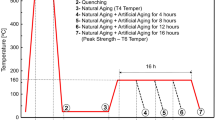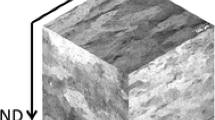Abstract
Residual stresses were determined through the thickness of quenched and quenched followed by cold compression 7050 aluminum alloy T-section forgings using the contour method and neutron diffraction. 7050 T-section forgings are used for the manufacture of the connecting joints of wing and fuselage. Inevitably high residual stresses are introduced during the quenching process of 7050 T-section forgings, which could be reduced by cold compression to overcome the effect of residual stress on machining deformation. The longitudinal residual stresses obtained by the two techniques achieved good agreement in both trend and magnitude in both the quenched and quenched followed by cold compression 7050 T-section forgings. The stress-free lattice spacing of Al(311), the Bragg reflection used for the neutron measurements, was obtained from a 5-mm slice using the plane-stress condition, and its variation through the thickness is insignificant in both the quenched specimen and quenched followed by cold compression specimen. A comparison of the residual stresses in the quenched specimen and quenched followed by cold compression specimen showed significant changes in range of residual stresses from (− 304, 262 MPa) induced by quenching process to (− 125, 142 MPa) due to 3% cold compression. The percentage reduction in residual stress in the quenched specimen due to 3% cold compression was (46, 59%).












Similar content being viewed by others
References
E.A. Starke Jr., and J.T. Staley, Application of Modern Aluminum Alloys to Aircraft, Prog. Aerosp. Sci., 1996, 32, p 131–172. https://doi.org/10.1016/0376-0421(95)00004-6
J.C. Williams and E.A. Starke Jr., Progress in Structural Materials for Aerospace Systems, Acta Mater., 2003, 51, p 5775–5799. https://doi.org/10.1016/j.actamat.2003.08.023
A. Heinz, A. Haszler, C. Keidel, S. Moldenhauer, R. Benedictus, and W.S. Miller, Recent Development in Aluminium Alloys for Aerospace Applications, Mater. Sci. Eng. A, 2000, 280, p 102–107. https://doi.org/10.1016/S0921-5093(99)00674-7
J.S. Robinson, D.A. Tanner, C.E. Truman, A.M. Paradowska, and R.C. Wimpory, The Influence of Quench Sensitivity on Residual Stresses in the Aluminium Alloys 7010 and 7075, Mater. Charact., 2012, 65, p 73–85. https://doi.org/10.1016/j.matchar.2012.01.005
J.S. Robinson, D.A. Tanner, S. Van Petegem, and A. Evans, Influence of Quenching and Aging on Residual Stress in the Al-Zn-Mg-Cu Alloy 7449, Mater. Sci. Technol., 2012, 28, p 420–430. https://doi.org/10.1179/1743284711Y.0000000063
S. Rasouli Yazdi, D. Retraint, and J. Lu, Study of Through-Thickness Residual Stress by Numerical and Experimental Techniques, J. Strain Anal. Eng. Des., 1998, 33, p 449–458. https://doi.org/10.1243/0309324981513147
M. Koç, J. Culp, and T. Altan, Prediction of Residual Stresses in Quenched Aluminum Blocks and Their Reduction Through Cold Working Processes, J. Mater. Process. Technol., 2006, 174, p 342–354. https://doi.org/10.1016/j.jmatprotec.2006.02.007
J.S. Robinson, D.A. Tanner, C.E. Truman, and R.C. Wimpory, Measurement and Prediction of Machining Induced Redistribution of Residual Stress in the Aluminium alloy 7449, Exp. Mech., 2011, 51, p 981–993. https://doi.org/10.1007/s11340-010-9389-4
H. Gong, Y. Wu, and K. Liao, Prediction Model of Residual Stress Field in Aluminum Alloy Plate, J. Central South Univ. Technol., 2011, 18, p 285–289. https://doi.org/10.1007/s11771-011-0692-8
N. Chobaut, J. Repper, T. Pirling, D. Carron, and J-M. Drezet, Residual stress analysis in AA7449 As-Quenched Thick Plates Using Neutrons and FE Modeling, in ICAA13: 13th International Conference on Aluminum Alloys (2012), p 285–291. https://doi.org/10.1002/9781118495292
N. Chobaut, D. Carron, S. Arsène, P. Schloth, and J.-M. Drezet, Quench Induced Residual Stress Prediction in Heat Treatable 7xxx Aluminium Alloy Thick Plates using Gleeble Interrupted Quench Tests, J. Mater. Process. Technol., 2015, 222, p 373–380. https://doi.org/10.1016/j.jmatprotec.2015.03.029
D.A. Tanner and J.S. Robinson, Residual Stress Magnitudes and Related Properties in Quenched Aluminium Alloys, Mater. Sci. Technol., 2006, 22, p 77–85. https://doi.org/10.1179/174328406X79414
M.B. Prime and M.R. Hill, Residual Stress Stress Relief and Inhomogeneity in Aluminium Plate, Scr. Mater., 2002, 46, p 77–82. https://doi.org/10.1016/S1359-6462(01)01201-5
J.-M. Drezet, A. Evans, and T. Pirling, Residual Stresses in DC Cast Aluminum Billet-Neutron Diffraction Measurements and Thermomechanical Modeling, in The 14th International ESAFORM Conference on Material Forming AIP Conference Proceedings 1353(2011), p 1131–1136. https://doi.org/10.1063/1.3589668
J.S. Robinson, S. Hossain, C.E. Truman, A.M. Paradowska, D.J. Hughes, R.C. Wimpory, and M.E. Fox, Residual Stress in 7449 Aluminium Alloy Forgings, Mater. Sci. Eng. A, 2010, 527, p 2603–2612. https://doi.org/10.1016/j.msea.2009.12.022
J.S. Robinson, P.J. Tiernan, and J.F. Kelleher, Effect of Post-Quench Delay on Stress Relieving by Cold Compression for Aluminum 7050, Mater. Sci. Technol., 2015, 31, p 409–417. https://doi.org/10.1179/1743284714Y.0000000571
J.S. Robinson, D.A. Tanner, and P.J. Tiernan, The Effect of Post Delay Quench Delay on Residual Stresses in Cold Compressed Aluminum Forgings, in Proceeding of 15th International Conference on Experimental Mechanics (2012), p 1–2.
D.A. Tanner, J.S. Robinson, and R.L. Cudd, Cold Compression Residual Stress Reduction in Aluminium Alloy 7010, Mater. Sci. Forum, 2000, 347–349, p 235–240. https://doi.org/10.4028/www.scientific.net/MSF.347-349.235
J.S. Robinson, S. Hossain, C.E. Truman, E.C. Oliver, D.J. Hughes, and M.E. Fox, Influence of Cold Compression on the Residual Stresses in 7449 Forgings, Adv. X-Ray Anal., 2009, 52, p 667–674
D.A. Tanner and J.S. Robinson, Modelling Stress Reduction Techniques of Cold Compression and Stretching in Wrought Aluminium Alloy Products, Finite Elem. Anal. Des., 2003, 39, p 369–386. https://doi.org/10.1016/S0168-874X(02)00079-3
M.B. Prime, M.A. Newborn, and J.A. Balog, Quenching and Cold-Work Residual Stresses in Aluminum Hand Forgings: Contour Method Measurement and FEM Prediction, Mater. Sci. Forum, 2003, 426–432, p 435–440. https://doi.org/10.4028/www.scientific.net/MSF.426-432.435
Z. Zhang, Y. Yang, L. Li, B. Chen, and H. Tian, Assessment of Residual Stress of 7050-T7452 Aluminum Alloy Forging Using the Contour Method, Mater. Sci. Eng. A, 2015, 644, p 61–68. https://doi.org/10.1016/j.msea.2015.07.018
G.S. Schajer, Practical Residual Stress Measurement Methods, Wiley, New Jersey, 2013
M.B. Prime, Cross-Sectional Mapping of Residual Stresses by Measuring the Surface Contour After a Cut, J. Eng. Mater. Technol., 2000, 123, p 162–168. https://doi.org/10.1115/1.1345526
M. Klasztorny, A. Bondyra, P. Szurgott, and D. Nycz, Numerical Modelling of GFRP Laminates with MSC.Marc System and Experimental Validation, Comput. Mater. Sci., 2012, 64, p 151–156. https://doi.org/10.1016/j.commatsci.2012.05.024
M.T. Hutchings, P.J. Withers, T.M. Holden, and T. Lorentzen, Introduction to the Characterization of Residual Stress by Neutron Diffraction, 1st ed., Taylor and Francis, London, 2005
R.C. Wimpory, P. Mikula, J. Ŝaroun, T. Poeste, J. Li, M. Hoffmann, and R. Schneider, Efficiency Boost of the Materials Science Diffractometer E3 at BENSC: One Order Of Magnitude Due to a Horizontally and Vertically Focusing Monochromator, Neutron News., 2008, 19, p 16–19
T. Gnäupel-Herold, ISODEC: Software for Calculating Diffraction Elastic Constants, J. Appl. Crystallogr., 2012, 45, p 573–574. https://doi.org/10.1107/S0021889812014252
C. Randau, U. Garbe, and H.-G. Brokmeier, StressTextureCalculator: a Software Tool to Extract Texture, Strain and Microstructure Information from Area-Detector Measurements, J. Appl. Crystallogr., 2011, 44, p 641–646. https://doi.org/10.1107/S0021889811012064
Acknowledgments
This research activity was financially supported by the National Natural Science Foundation of China (Grant 11605293 and 51327902) and the State Key Laboratory of High Performance and Complex Manufacturing (Grant Kfkt2016-04).
Author information
Authors and Affiliations
Corresponding author
Rights and permissions
About this article
Cite this article
Liu, X., Wimpory, R.C., Gong, H. et al. The Determination of Residual Stress in Quenched and Cold-Compressed 7050 Aluminum Alloy T-Section Forgings by the Contour Method and Neutron Diffraction. J. of Materi Eng and Perform 27, 6049–6057 (2018). https://doi.org/10.1007/s11665-018-3676-0
Received:
Revised:
Published:
Issue Date:
DOI: https://doi.org/10.1007/s11665-018-3676-0




